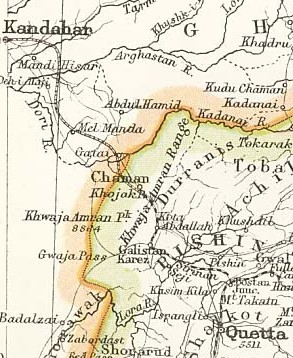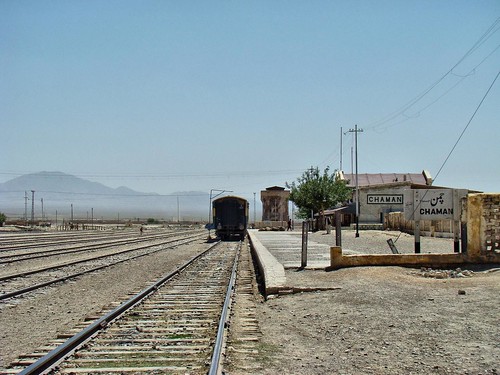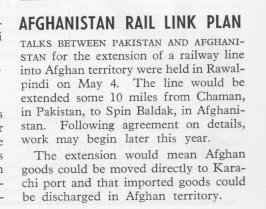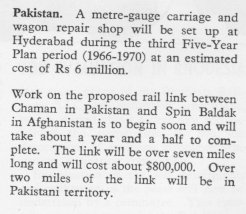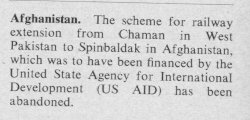I’ve had a number of e-mails lately about mentions of Afghan railways in Wikileaks, so I probably ought to do something with them.
This message was reported by Aftenposten on 25 January 2011 but dated “1.2.2010” by the newspaper (1 February 2010, assuming the newspaper is using European date formats). There doesn’t appear to be anything militarily sensitive here, just a bit of interesting stuff about railways, answering some questions. There is confirmation of the Iranian project, pessimism about the copper mine railway plan, and it ends by not sounding very keen on railway development at all.
SECRET SECTION 01 OF 02 KABUL 000388
SIPDIS
E.O. 12958: DECL: 01/26/2035
TAGS: ELTN, EINV, ECON, PGOV, AF, IR
SUBJECT: Rail Projects Underway, But a Uniform Network Remains Elusive
Classified By: Ambassador E. Anthony Wayne for reasons 1.4 b and d.
1. (U) Summary: While two rail construction projects in Afghanistan are underway
Hairatan – Mazar-i-Sharif and Iran – Herat
and several more are under discussion, the dream of a nationwide rail network remains remote. Small-scale projects sponsored by neighboring countries require different rail gauges, matching those of the countries these projects border; while the security situation is delaying two projects and likely deterring proposals for more. The enforcement of a single rail gauge is not practical since it would fail to make connections with at least half of Afghanistan´s neighbors. The Afghan Government must obtain funding f´ and build gauge changing stations if it is serious about connecting Afghanistan´s major population centers and industrial areas by train. End Summary.
Herat and Mazar: The Trains Have Left the Station
– – – – – – – – – – — – – – – – – – – – – – – — – – – –
2. (S) The rail link from Herat to Torbat-E Heydarieh, Iran, funded by the Iranian Government, is more than half complete. The section the Iranians are building and funding in Afghanistan is approximately 60 km from their border eastward toward Herat. The Afghan government under the original bilateral agreement with Iran is obligated to fund construction of the Afghan railroad’s second half, consisting of an additional 60 km of track onward to the western suburbs of Herat city. Iran uses standard gauge (1435 millimeter) track within Iran and is likely to use track to this specification within Afghanistan. (Note: standard gauge is the predominate gauge in the United States.)
It would be strange to use any other gauge for this section of line, as presumably no-one will want to take traffic from Iran or Herat to the frontier point and no further.
3. (SBU) Afghan Government officials toured the Iranian-funded portion of the project January 16 [2010] and were reportedly told by Iranian engineers that the rail bed was essentially completed and the rail laying could be completed in 60 days. They also met Afghan owners of property along the first half of the portion of the railroad to be funded by the Afghan government and informed them they would be compensated for the right of way within 20 to 30 days. The Afghan Ministry of Finance has allotted 97 million Afghanis (a little less than $2 million) for this. Herat Governor Nuristani said the Ministry of Finance has promised approximately $55 million for constructing the last stage of the railway, including compensating landowners for right of way for the second half of Afghan portion. Under the terms of the agreement to build the rail line, Afghanistan promised to fund construction of half of the project within its borders and Iran committed to the other half within Afghanistan, as well as extending its own rail line to the border with Afghanistan.
This ties in with what I have heard elsewhere, but puts some numbers on it.
4. (S) Extending from the Afghan/Uzbek border at Hairaton to Mazar-i-Sharif, an Asian Development Bank (ADB)-funded, Uzbek Railways-constructed track will soon be under construction. The 75 kilometer rail line will cost approximately $170 million. ADB awarded the contract in October 2009. Uzbek Government-owned Uzbek Rail agreed to begin construction in December and finish by the end of 2010. However, security concerns have delayed Uzbek Rail´s construction preparations, such as barracks for workers (all of whom will come from Uzbekistan). Uzbek Rail asked ISAF to provide security forces for the site. ISAF was unable to do so but did agree to share actionable intelligence with Afghan National Security Forces (ANSF) and assured the company that ANSF would provide security. According to a source in Tashkent, Uzbek Rail deemed ANSF protection insufficient and entered contract talks with an American private security contractor. The source also indicated Uzbek President Islom Karimov had ordered the company to start work immediately in early January.
I wonder why ISAF was unable to be involved?
5. (U) The railroad will be 1520 millimeter gauge, the standard across the former Soviet Union. It will connect with existing Uzbek tracks at Termez, Uzbekistan. This rail line is important to coalition forces in Afghanistan, who hope it can speed up the delivery of crucial supplies through the Northern Distribution Network, routing shipments through the former Soviet states to Afghanistan.
This is where it gets interesting:
Pakistani and Chinese Projects Off the Rails
– – – – – – – – – – — – – – – – – – – – – –
6. (C) When China Metalurgical Corporation (MCC) won the tender for Aynak copper mine in 2008, its bid included a promise to build a rail line “associated with the project.” The line would carry copper concentrate and eventually smelted copper to more accessible locations for onward distribution. In January 2010, World-Bank-funded analysts and a private MCC contractor told us the company currently considers the railway not feasible. During a meeting at the mine in September 2009, MCC leadership mentioned what they viewed as “flexible” the requirement to put in the rail, which then-Minister of Mines Adel roundly contradicted, saying the rail was required and “non-negotiable.” A draft of the contract obtained by the Embassy states that “MCC has made a commitment to the Government of Afghanistan to construct, at MCC´s sole expense, a railway associated with the Project…the Parties acknowledge and agree thatthe failure to conclude a railway agreement within this timeframe shall constitute cause for the Parties to revoke this Mining Contract.” In a recent Ambassadorial meeting, Minister of Mines Shahrani said the Aynak contract requires MCC to build “two rail lines” one north and one east, a statement inconsistent with our unofficial copy of the contract. The Embassy and World Bank analysts continue to encourage the Ministry to make the Aynak contract public for transparency reasons. If this occurs, however, the fact that MCC has still not completed an addendum to the contract that would specify when and where rail will be built may provoke controversy.
7. (U) Pakistani media reported January 17 that work on a Quetta-Kandahar rail line would begin soon.
Although it has been going to begin soon for well over 100 years…
The track is complete from Quetta to the Pakistani border at Weesh Chaman, however, the remaining seven kilometers of track to the Afghan border post at Spin Boldak, as well as the remaining 111 kilometers to Kandahar, are “on hold” by the Afghan Ministry of Public Works due to security concerns. Assuming Afghanistan and Pakistan do not build a facility to transfer cargo or change gauges at the border, the rail gauge would be 1,676 millimeters, known as broad gauge, the standard across the Asian sub-continent.
A gauge changer wouldn’t make much sense on a line which only went as far as Spin Boldak.
Hodgepodge Gauges: Problematic but Not the End of the Line
– – – – – – – – – – — – – – – – – – – – – – – – – – – – –
8. (U) With three different rail gauges potentially entering the country, freight will need to be offloaded at break of gauge or facilities must be built to lift cars from the tracks and change their bogies (the chassis of a railway car.)
As a very minor point of note, the message says “bogies”, rather than the more usual US-English term “trucks”.
Changing the bogies on a 50-car train should take approximately five hours and could coincide with customs processing. However, it will significantly delay future passenger and freight trains if the independent lines ever connect. Dependent on donor funding for its rail development, Afghanistan is presently not in a position to enforce a single national rail gauge and must plan to mitigate the economic impact of multiple gauges. The ADB and other independent studies have recommended that Afghanistan adopt the Russian 1520 millimeter gauge within Afghanistan and install gauge change stations at Herat and Kandahar City. (Note: Dual- or variable-gauge tracks avert the need for specialized facilities but cost significantly more to build. To Post´s knowledge, no donor has expressed interest in funding this additional cost. End note.)
Presumably this is saying 1520 gauge from Hairatan – Mazar-i-Sharif – Herat (interchange with 1435 line to Iran) – Kandahar (interchange with 1676 line to Pakistan). That leaves open the question of the Chinese copper line, were it to be deemed feasible.
9. (U) Rail traffic volumes are also an issue. The general rule of thumb is that a rail line is not economically viable with less than 5 million tons of throughput. Anything less than this is more efficiently handled by trucks.
Anyone got any thoughts on those figures?
The anticipated volumes from and through Afghanistan to Iran fall far short of this.
10. (U) Comment: Many countries, including Australia, Tanzania and Angola, operate railroads of different gauges.
As I understand it Angloa is all 1067 mm (Cape gauge) now. The railways are all independent lines running inland from ports, with little prospect of lines being built parallel to the coast to link them up.
These gauge differences become significant, however, as the number of gauges proliferate within country. On the other hand, even the most far-sighted donor would hesitate to build a link to Afghanistan requiring cargo to be offloaded at its border or the construction of an expensive break of gauge facility. It is clearly in the interests of Afghanistan´s neighbors to seek matching rail gauges within Afghanistan, and, unfortunately, Afghanistan is not in a position to adopt a single common rail gauge that would isolate it from at least half of its neighbors. We are encouraging the Afghan Government to plan wisely when evaluating future rail projects and consider the impact of volume and gauge changes on rail efficiency and economy.
End comment.
11. Embassy Tashkent has cleared this cable.
EIKENBERRY
Code for “we don’t think railways are a good idea”?
There are also cables regarding 05.10.2009: Security and Social Issues at Aynak Copper Mine:
Reportedly, MCC has also signed a memorandum of agreement committing to lay a rail line running north and south, connecting Aynak with the proposed Hajigak iron mine and its associated coking coal mine in Bamyan province.
4. (SBU) During a September 17 [2009] meeting with Mining Minister Adel, Aynak Police Commander Mohammad Mosen, and U.S. military and civilian representatives, MCC-Aynak President Zou suggested that MCC may not build a rail line for Aynak. Minister Adel insisted that MCC has a contractual commitment to install the line, but admitted in a later aside that the rail contract had not yet been signed.
And 10.12.2009: Chinese Firm Re-Thinks Afghan Mining Contract After Difficulties Of The Aynak Copper Mine Project:
[China Metallurgical Group Corporation President Shen Heting told a visiting U.S. delegation] existing roads would be sufficient to transport the copper from the mine and that construction of a railway from the mine to the Pakistan port of Gwadar was not economically justified. However, he reiterated that the Chinese government was urging the company to honor its commitments, suggesting that MCC might eventually build some railway.
